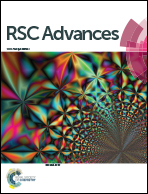In silico prediction of chronic toxicity with chemical category approaches†
Abstract
Chemical chronic toxicity, referring to the toxic effect of a chemical following long-term or repeated sub lethal exposures, is an important toxicological end point in drug design and environmental risk assessment. Owing to the high cost and laboriousness in experimental tests, it is very necessary to develop in silico methods to assess the chronic toxicity of compounds. In this paper, we collected a large data set containing 567 diverse compounds with the lowest observed adverse effect level (LOAEL) values determined in rats by oral administration. A series of models were developed combining with five machine learning methods and six fingerprint types based on four different thresholds discriminated chemicals with chronic toxicity from those without chronic toxicity. Meanwhile, chemicals were also grouped into three classes (strong, moderate and weak chronic toxicity) and models were developed using the extreme parts (strong and weak chronic toxicity). Finally, we proposed eight privileged substructures using substructure frequency analysis method. These privileged substructures could be regarded as structural alerts of chronic toxicity. The models and privileged substructures could provide critical information and useful tools for chemical chronic toxicity assessment in drug discovery and environmental risk assessment.



 Please wait while we load your content...
Please wait while we load your content...